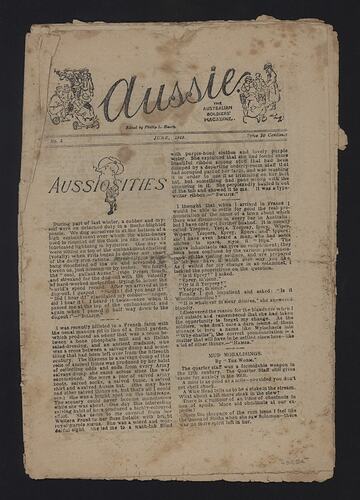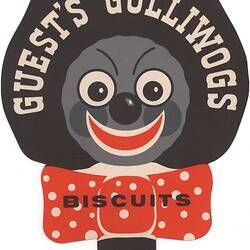Summary
Issue no.5, June 1918, of World War I-era publication titled 'Aussie', 'The Australian Soldiers' Magazine'. Printed in the field by the AIF Printing Section.
One of a collection of copies of 'Aussie' magazines in Museum Victoria's collection dated 5 June 1918 - 15 January 1929.
'Aussie' (1918- circa 1929) was a commercial magazine of opinion, review and entertainment. It was edited by Phillip Harris and published in France 1918 - 1919 on a small printing press that Harris brought with him to France. Initially the print run was only 10,000 copies, but soon it reached 60,000 and later 100,000. The magazine aimed to celebrate a distinctive 'Aussie' identity through language, humour and imagery. It distributed news, provided light-hearted ways of seeing the war experience and gave soldiers an outlet to express dissent or dissatisfaction. It also provided a voice for Australian authors such as Banjo Paterson, C.J. Dennis and Bernard O'Dowd. The magazine also frequently contained deeply racist and sexist imagery and references.
After the war, Phillip Harris produced a monthly in Sydney and renamed it 'Aussie: the Cheerful Monthly' from 1920. It built a sizeable circulation and for several years it published the major Australian writers and cartoonists of the day. It set out to sustain the digger culture and defend the rights of the veterans, while also embracing the re-adjustment of returned soldiers into civilian life.
'Aussie' magazines frequently portray cultural and racial groups in a derogatory way in order to amuse readers. Nicknames and terms of ridicule are used to describe a 'stereotypical' person of British, German, African American, First Peoples (Australia) or Chinese background. In addition an exaggerated accent from the targeted person or nationality comes across in the dialogue which accompanies many cartoons.
Physical Description
Magazine printed on A4 paper in black ink, double sided, 10 pages. Comprised of stories, illustrations, songs and poetry from the First World War. The front page contains 'Aussie' logo and publication details and the beginnings of an article titled 'Aussiosities'. All pages are very fragile.
Significance
This object provides an Australian soldiers' view of the political and world climate during World War I, and also represents the bond between Australian soldiers. The magazine celebrated a distinctive 'Aussie' identity, through language, humour and their assertion of what it meant to be an Australian. It allowed news to be distributed, gave the soldiers an outlet to express any dissent or dissatisfaction, thus preventing any greater form of rebellion and promoted Australian authors like Banjo Paterson, C.J. Dennis and Bernard O'Dowd. After the war, Phillip Harris produced a monthly in Sydney from 1920 and renamed it: 'Aussie: the Cheerful Monthly'. It built a sizeable circulation and for more than a decade it published the major Australian writers and cartoonists of the day. It set out to sustain the digger culture and defend the rights of the veterans, while also embracing the re-adjustment of returned soldiers into civilian life.
'I claim no credit for the success of Aussie. That belongs to the Diggers. Aussie was not a paper done for the Diggers, but by them. That's why it reflects their spirit.' - Phillip L. Harris, Editor, taken from 'The Story of Aussie'
More Information
-
Collection Names
Returned and Services League (RSL) Collection, Military Memorabilia Collection
-
Collecting Areas
-
Acquisition Information
Donation from Mr J. Russell, 18 Mar 1986
-
Publisher
Printing Section, Australian Imperial Force (AIF), France, Jun 1918
-
Editor
-
Inscriptions
Printed on cover: Aussie/ THE AUSTRALIAN SOLDIERS' MAGAZINE./ Edited by Phillip L. Harris/ No. 5, JUNE, 1918. Price 10 Centimes./ AUSSIOSITIES/ During part of last winter, a cobber and my- / self were on detached duty in a Boche-blighted / possie. We dug ourselves in at the bottom of a / high embankment over which the whizz-bangs / used to ricochet off the thick ice like streaks of / lubricated lightning in hysterics. One day we / were sitting on top of the embankment chatting / (vocally) when Fritz began to deliver our share / of the daily iron rations. Presently a whizz- / bang ricocheted off the ice and screamed be- / tween us, just missing us by inches. We forgot / the "cool, gallant Anzac" (vide Press) touch, / and streaked for the dug-out with velocity / of hard-worked meteroites trying the lower the / world's speed record. After we arrived at the / dug-out I gasped: "Struth! did you hear it?" / "Did I hear it?" ejaculated my cobber - "cripes, / did I hear it. I heard it twice, once when it / passed me at the top of the embankment and / again when I passed it half way down to the / dugout!" [extensive text]
-
Classification
-
Category
-
Discipline
-
Type of item
-
Overall Dimensions
18.2 cm (Width), 26.5 cm (Height)
-
References
Amanda Laugesen, (2003) 'Aussie Magazine and the Making of Digger Culture during the Great War' National Library of Australia News (November), pp.15-18
-
Keywords
World War I, 1914-1918, Magazines, Military History, Militaria: Australian, Cultural Stereotypes

